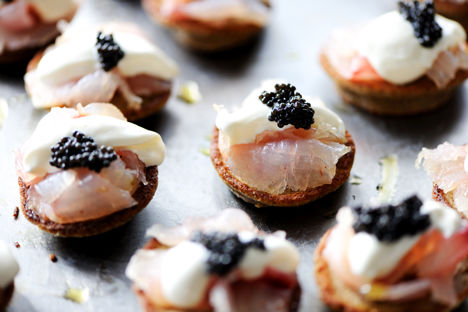
Making the grade: a guide to caviar
Our guide to the different varieties, how to appreciate its flavour and what to serve it with will turn you into a caviar connoisseur in no time.
Making the grade: a guide to caviar
Our guide to the different varieties, how to appreciate its flavour and what to serve it with will turn you into a caviar connoisseur in no time.
You don’t have to be an oligarch to enjoy caviar these days. If you’re hosting a dinner party where you want to impress, looking for that special something to kick off your Christmas dinner with a decadent bang or are just curious to try such a highly regarded product, it’s certainly worth buying a tin. But with so many different varieties, farming methods and grading systems, it can be hard to know where to start.
Put simply, caviar is nothing more than salted fish roe (eggs) left to mature. There are all sorts available, from bright orange salmon roe to golden Arctic char eggs. However, the one most people think of is the dark brown and black sturgeon caviar; the most highly regarded of all. While you might see wild caviar for sale, it’s actually illegal to sell it; farmed varieties are just as good, more affordable and consistent. The basic flavour of caviar is salty and creamy, with a mineral, oceanic aftertaste, although the various types contain subtle differences.
Different varieties
There are four well known types of Caspian sturgeon – Beluga, Oscietra, Sevruga and Baerii – which are commonly farmed to produce good caviar, each with their own flavour profile, texture and colour. There are also lots of hybrids between the species bred in caviar farms, and even more species in the world’s oceans. Once the eggs have been collected, the majority are sorted and sold into the following categories:
Royal Beluga – the most expensive, rarest caviar you can buy. Beluga eggs are the largest, so they have more of a ‘popping’ texture with a creamy, buttery, smooth flavour and hints of walnut.
Royal Oscietra – smaller eggs than Beluga with a nutty, slightly fruity flavour that lingers on the tongue. Oscietra eggs can be anything from dark brown to light grey or golden.
Oscietra – these are the Oscietra eggs which aren’t big enough to be classed as ‘Royal’. This means the texture isn’t as satisfying but the flavour is just as good. It’s cheaper, too, so it’s a common recommendation for beginners.
Sibirskye – this is made from the very dark eggs of Siberian Baerii sturgeon. It lacks the subtlety and lingering taste of Beluga and Oscietra caviar, but delivering a burst of flavour the second it hits your tongue instead.
Sevruga – these small eggs make up in flavour what they lack in texture. Big, salty, rich, intense and unique.
Note that the most expensive caviar doesn’t necessarily mean it’s the most delicious – the price simply reflects how rare it is. Many caviar connoisseurs prefer the flavour of Oscietra or Sevruga over Beluga eggs – it’s down to personal preference.
How to taste
Caspian Caviar
Once you’ve decided on a variety of caviar, you’ll want to know how to get the most flavour out of the eggs. The most important thing to remember is to never use a steel, silver or bronze spoon; the metal will react with the eggs and spoil their flavour. Spoons made from mother of pearl are the traditional choice (and look very nice against the shiny black eggs), but wooden or plastic cutlery is also fine. Professional tasters place a small spoonful of caviar on the back of their hand before tasting, as it’s believed to be the most neutral-tasting surface.
When the caviar is on your tongue, roll the eggs around the roof of your mouth to separate them. Breathe in through your nose and crush the caviar; the eggs will begin to pop, which is when they will release their full flavour. Continue to breathe in through your nose when you swallow them, to help the lingering aftertaste last longer. Some basic descriptions of caviar’s flavour are buttery, nutty, earthy, salty and fishy, but it’s hard to put into words its delicate complexity.
Accompaniments
Purists would have nothing more than a glass of water alongside their caviar, so they could appreciate the delicacy’s full flavour. However, this isn’t really suitable for a dinner party. Traditionally, Champagne or ice-cold vodka would be served with caviar; the buttery fizz of Champagne works wonderfully with caviar’s melting, mineral flavours, while vodka’s clean, refreshing taste is subtle enough not to overpower. Avoid wines or anything with a stronger flavour.
Serving caviar on blinis or melba toast is suitably bland, and you can top them with a dollop of sour cream and a sprinkling of chives for an incredibly luxurious canapé. If you want to incorporate them into a recipe, then fish is usually a good match; try Will Holland’s Lobster and caviar gratin or Luke Tipping’s Citrus-cured salmon with avocado purée and caviar. However, if it’s your first time trying caviar, don’t overcomplicate things – the natural flavour of sturgeon eggs is amazingly complex.


